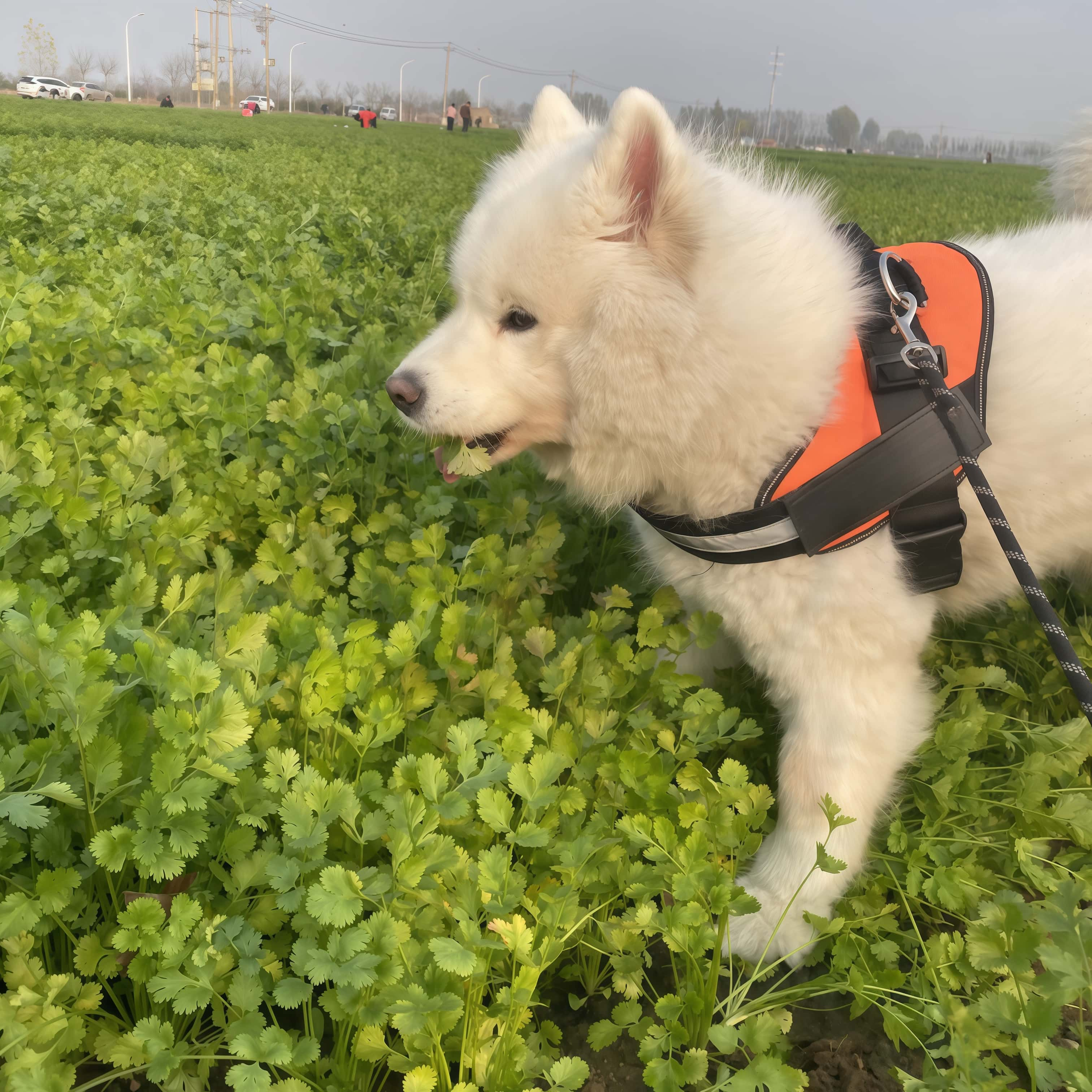1.Conclusion (Quick Answer)
(1)First, let's talk about the conclusion:
Can dogs eat cilantro? Yes, dogs can safely eat cilantro in small amounts, as it’s a non-toxic herb that provides essential vitamins (A, C, K), antioxidants, and minerals like potassium, while supporting digestion, freshening breath, promoting immune and skin health, and serving as a low-calorie addition to their diet.
(2)Recommended Dosage:
The ideal amount of cilantro depends on your dog's size(Always start with a smaller quantity (e.g., half the recommended dose) to ensure your dog tolerates it well):
- Small dogs (under 20 pounds, e.g., Chihuahuas, Dachshunds): 1 teaspoon of finely chopped cilantro per meal.
- Medium dogs (20-50 pounds, e.g., Beagles, Cocker Spaniels): 2-3 teaspoons per meal.
- Large dogs (over 50 pounds, e.g., Labradors, German Shepherds): Up to 5 teaspoons per meal.
(3)When and How to Serve:
Timing: It’s best to serve cilantro with their regular meal. Mixing it into their food ensures even distribution and allows it to aid digestion as part of a balanced diet.
Preparation: Finely chop the cilantro and mix it into their food. This helps the dog consume it more easily and avoids overwhelming them with the taste.
(4)Important Considerations:
Avoid feeding cilantro on an empty stomach, as it might be too strong for some dogs' digestive systems.
2. Personal Experience: My Dogs and Cilantro

If I didn’t have this video, you probably wouldn’t believe me when I say that my dogs absolutely love eating cilantro. Yes, you heard that right—cilantro, the herb with a strong, unique flavor, has somehow become their favorite treat.
I have three dogs, and one day, while cooking, I accidentally dropped some cilantro on the floor. Before I could pick it up, one of my dogs quickly ate it, which immediately made me wonder: Can dogs eat cilantro? At that moment, I panicked, worried if cilantro might be toxic to dogs.
Out of concern, I immediately consulted a few veterinarians to confirm whether cilantro was safe. To my relief, they assured me that cilantro is non-toxic to pets, which gave me peace of mind.
Since then, I’ve occasionally added cilantro to my dogs’ meals to let them experience different flavors. Interestingly, I noticed that one of my dogs absolutely dislikes cilantro. Whenever it’s mixed in their food, they avoid eating the portions touched by cilantro. However, the other two dogs seem to find the flavor intriguing and enjoy it.
This reminded me of how humans react to cilantro. Some people adore its unique taste, while others try to avoid it at all costs. It seems my dogs are just as divided about cilantro as we are!
3.Benefits of Cilantro for Dogs
Many people wonder, Can dogs eat cilantro? However, most people don’t realize that cilantro offers numerous benefits for dogs.
(1)Rich in Nutrients:
- Vitamins A, C, and K: Boosts immunity and promotes healthy skin and coat.
- Potassium and manganese: Supports proper muscle function and overall health.
(2)Digestive Support:
- Helps soothe mild stomach discomfort and reduce bloating.
- Aids in gut health by supporting proper digestion and preventing gas buildup.
(3)Freshens Breath:
- Cilantro's natural oils can help combat bad breath in dogs, leaving their mouth fresher.
(4)Antioxidant Properties:
- Packed with antioxidants that protect cells from damage.
- Supports overall immune system function and fights inflammation.
(5)Detoxifying Effect:
- Known to help remove heavy metals and toxins from the body (though more research is needed for pets).
(6)Low-Calorie Addition:
- A healthy, low-calorie herb that can add flavor to your dog's diet without adding unnecessary weight.


4.Risks of Feeding Cilantro to Dogs
(1)Allergic Reactions:
- Some dogs may be allergic or sensitive to cilantro, which could result in symptoms like: Itching or skin irritation. Swelling around the face, lips, or paws. Vomiting or diarrhea after consumption.
- Always monitor your dog for signs of an allergic reaction when introducing cilantro for the first time.
(2)Taste Aversion:
- Not all dogs enjoy the flavor of cilantro.
- Forcing cilantro into their meals could lead to them refusing food entirely.
(3)Pesticides and Contaminants:
- Cilantro from non-organic sources may carry pesticides or harmful contaminants.
- Thoroughly wash the cilantro before feeding it to your dog to ensure it’s free from any toxic residues.
5. How to Feed Cilantro to Dogs
(1)Start Small:
- When introducing cilantro to your dog’s diet for the first time, start with a small amount to see how they react.
- Begin with 1 teaspoon of finely chopped cilantro and adjust based on your dog’s size and tolerance.
(2)Mix it Into Their Food:
- The best way to serve cilantro is to mix it into your dog’s regular food to balance the flavor and make it easier to consume.
- Finely chop the cilantro to ensure even distribution in their meal.
(3)Follow Size-Specific Guidelines:
- Small dogs (under 20 pounds): 1 teaspoon per meal.
- Medium dogs (20-50 pounds): 2-3 teaspoons per meal.
- Large dogs (50+ pounds): Up to 5 teaspoons per meal.
- Always adjust the portion to fit your dog's weight and dietary needs.
(4)Combine With Other Dog-Safe Foods:
- Mix cilantro with dog-friendly foods like cooked rice, plain chicken, or steamed vegetables to add a new layer of flavor.
- Avoid using cilantro as a standalone snack; instead, use it as a supplement in balanced meals.
(5)Serve During Mealtime:
- Feed cilantro as part of your dog’s regular meal, as it helps aid digestion when combined with other foods.
- Avoid feeding cilantro on an empty stomach, as it may be too strong for some dogs.
(6)Use Fresh Cilantro:
- Always choose fresh, organic cilantro to avoid exposure to harmful pesticides or chemicals.
- Wash the cilantro thoroughly before chopping to ensure it is clean and safe for your dog.
(7)Frequency of Feeding:
- Cilantro should be treated as an occasional supplement, not a daily staple.
- Limit feeding to 1-2 times a week to avoid potential digestive upset.
(8)Avoid Cilantro Stems:
- While the leaves are safe and easy to digest, the stems may pose a choking hazard, especially for smaller dogs.
- Remove the stems and only feed the finely chopped leaves.
(9)Important Notes:
- Always monitor your dog for any adverse reactions when adding new foods to their diet.
- Consult your veterinarian before introducing cilantro if your dog has a sensitive stomach, existing medical conditions, or is on a restricted diet.
- Remember that cilantro is not a substitute for essential nutrients; it should complement, not replace, their regular balanced meals.
6. Conclusion
(1)Cilantro is safe for dogs to eat in moderation and can be a healthy addition to their diet. This non-toxic herb provides essential vitamins like A, C, and K, along with antioxidants and minerals such as potassium, supporting digestion, freshening breath, and promoting immune and skin health. However, it’s important to introduce cilantro gradually and in appropriate quantities based on your dog’s size and dietary needs.
(2)Not all dogs may enjoy cilantro’s unique flavor, and overfeeding can lead to digestive upset. Treat cilantro as an occasional supplement rather than a staple food, and ensure it’s properly washed and prepared before feeding.
(3)In summary, cilantro can be a nutritious and flavorful addition to your dog’s meals, helping them enjoy a variety of tastes while benefiting from its health-boosting properties.


Share: